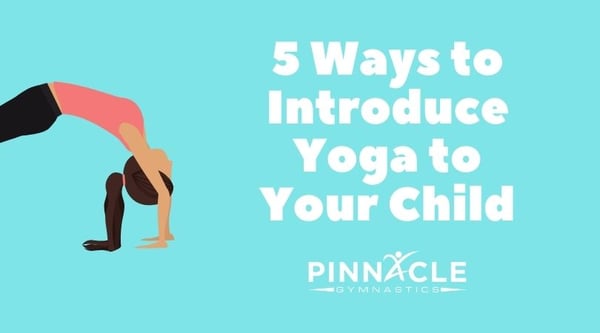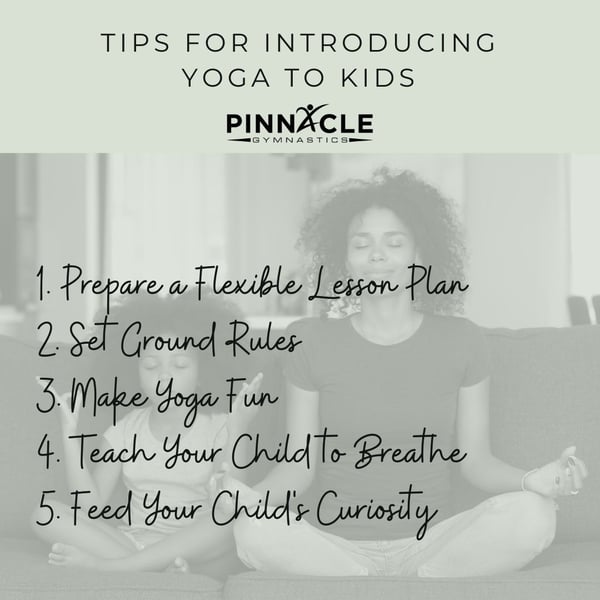Welcome to the 2020's and the fast paced world of...NOW. Everyone who's anyone knows that our world and day-to-day lives can be busy and sometimes chaotic. Our children are oftentimes running from school to activities and sometimes activity to activity, which can be overwhelming and exhausting both physically and mentally. It's so beneficial for our children to learn how to slow down, breathe, and be aware of their bodies. Yoga is just the exercise to help them do that. Yoga can have a positive impact on your child's well being and will provide very important life skills that can help her be successful.

Did you know that the practice of yoga offers a multitude of benefits for your child? Yoga can help your child to manage anxiety and stress by introducing breathing exercises and relaxation techniques that they'll carry with them through adulthood. Yoga can also boost your child's self esteem and increase their body awareness. By improving their balance and flexibility, your child will feel a sense of accomplishment, and will help them understand how their bodies move, all while reducing their chance for injury. Lastly, yoga helps teach discipline and can reduce impulsivity by offering your child an outlet for physical expression. So how can you create the best yoga experience for your child?

1. Prepare a Flexible Lesson Plan
Unlike adults, your preschooler is unlikely going to stand on the end of her yoga mat as you flow through various poses. Remember that your goal is to give your child what they need, even if it's just a couple poses for a couple of minutes. By making your yoga lesson hands-on and interactive, you'll have your child's attention for sure. One of my favorite yoga games to play with my preschool gymnastics classes is Fidget Spinner Yoga. This free printable game incorporates the fidget spinner, which each child loves to have a turn spinning. Watching the spinner go around and around until it lands on the yoga pose is fun and a guaranteed hit!
2. Set Ground Rules
Have a set of clear cut, simple expectations before your start your yoga practice. Your rules may include, 1. Be safe, 2. Have fun, 3. Ask questions, 4. Stay on your yoga mat. When you let children know the rules beforehand, you are setting yourself and your child up for success.
3. Make Yoga Fun
As every parent knows, we're competing with video games, tv's and other technology, so it's important to make the practice of yoga as fun as possible. One way to do this with your preschooler is to use your imaginations. Tell a story or sing as you introduce poses and include for example, a cat, a cow, or crossing a bridge as you model these postures. Remember not to focus too much on alignment but instead ask yourself; Is my child having fun? Are they safe? Relax, keep it playful and have fun!
4. Teach Your Child to Breathe
One of the most powerful and easiest practices to teach your child is breath awareness. Using the diaphragm to breath a deep and relaxed breath is the foundation of the practice. It activates the parasympathetic nervous system, which induces a sense of calm, improves focus and reduces anxiety.
One way to do this is to remember that the breathing we want to do is deep belly breaths, not shallow chest breaths. When your child breathes in, their belly should expand and when they breathe out, their belly should contract. Have your child lay down on their back and place a bean bag or stuffed animal on their belly. Instruct your child to breathe in, moving the animal up, breathing out and moving the animal down. This teaches your child to take deep, diaphragmatic breaths.
5. Feed Your Child's Curiosity
You may think that you must be silent and focused completely on the breath during yoga. But yoga time can also be a safe environment to foster creativity and can be an amazing opportunity for your child to come up with any questions that may pop into her head. If you'd like, you can raise your own questions to your child such as; How does yoga make you feel? Where in your body can you feel your breath? or What is your favorite pose? This is also a perfect time to start a gratitude practice with your child. Start each practice by asking them if they can name 3 things that they are thankful for.
Overall it's important to have fun, not take yourself or the practice of yoga too seriously, and to truly appreciate this time with your child. Enjoy!




